上海牛津小学英语语法知识总结
- 格式:docx
- 大小:19.22 KB
- 文档页数:9
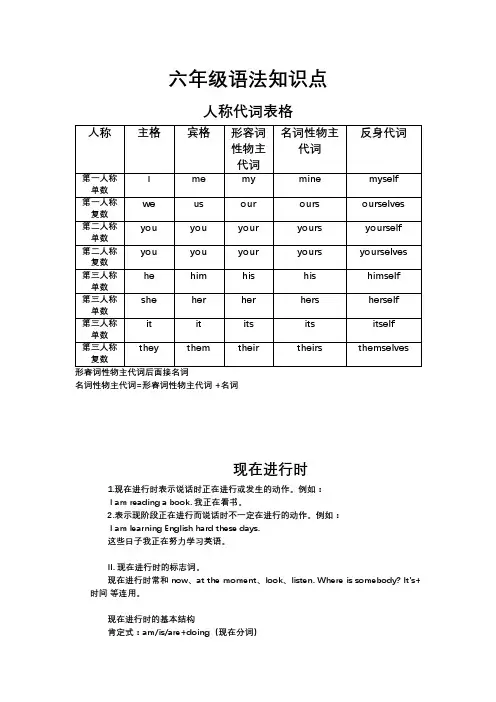
六年级语法知识点人称代词表格名词性物主代词=形容词性物主代词 +名词现在进行时1.现在进行时表示说话时正在进行或发生的动作。
例如:I am reading a book. 我正在看书。
2.表示现阶段正在进行而说话时不一定在进行的动作。
例如:I am learning English hard these days.这些日子我正在努力学习英语。
II. 现在进行时的标志词。
现在进行时常和now、at the moment、look、listen. Where is somebody? It’s+时间 等连用。
现在进行时的基本结构肯定式:am/is/are+doing(现在分词)They’re having a meeting now. 他们现在正在开会。
否定式:am/is/are not +doing(现在分词)They aren\'t having a meeting now. 他们现在没有在开会。
一般疑问式:Am/Is/Are + 主语 +doing(现在分词)+ 其他Are they having a meeting now? 他们现在正在开会吗?特殊疑问式:特殊疑问词+一般疑问式What are they doing now? 他们现在正在做什么?现在分词(doing)的变化规则1. 一般情况下,在动词词尾加ing。
go——goingplay——playingknow——knowing2. 以不发音的字母e结尾动词,先去e再加ing。
make——makingarrive——arrivinge——ing3. 以重读闭音节结尾,且动词词尾只有一个辅音字母时,先双写这个辅音字母,再加ing。
run——runningstop——stoppingswim——swimmingrun——runningput——puttingsit——sittingbegin——beginningplan——planningcut——cuttingget——gettingshop——shoppingchat——chattingregret——regrettingdig——digging4. 以ie结尾,先将ie改成y,再加ing。
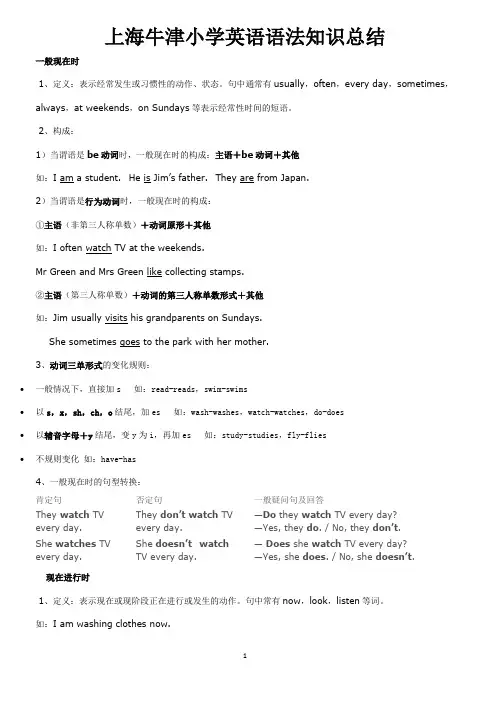
上海牛津小学英语语法知识总结一般现在时1、定义:表示经常发生或习惯性的动作、状态。
句中通常有usually,often,every day,sometimes,always,at weekends,on Sundays等表示经常性时间的短语。
2、构成:1)当谓语是be动词时,一般现在时的构成:主语+be动词+其他如:I am a student. He is Jim’s father.They are from Japan.2)当谓语是行为动词时,一般现在时的构成:①主语(非第三人称单数)+动词原形+其他如:I often watch TV at the weekends.Mr Green and Mrs Green like collecting stamps.②主语(第三人称单数)+动词的第三人称单数形式+其他如:Jim usually visits his grandparents on Sundays.She sometimes goes to the park with her mother.3、动词三单形式的变化规则:•一般情况下,直接加s 如:read-reads,swim-swims•以s,x,sh,ch,o结尾,加es 如:wash-washes,watch-watches,do-does•以辅音字母+y结尾,变y为i,再加es 如:study-studies,fly-flies•不规则变化如:have-has4、一般现在时的句型转换:肯定句否定句一般疑问句及回答They watch TV every day. They don’t watch TVevery day.—Do they watch TV every day?—Yes, they do. / No, they don’t.She watches TV every day. She doesn’t watchTV every day.—Does she watch TV every day?—Yes, she does. / No, she doesn’t.现在进行时1、定义:表示现在或现阶段正在进行或发生的动作。
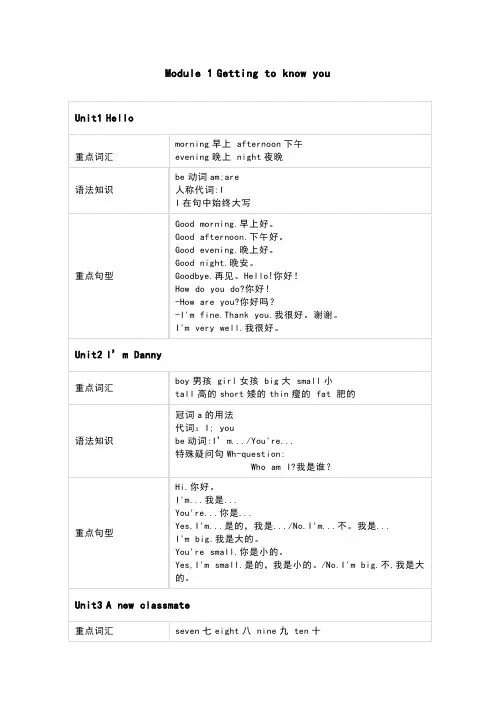
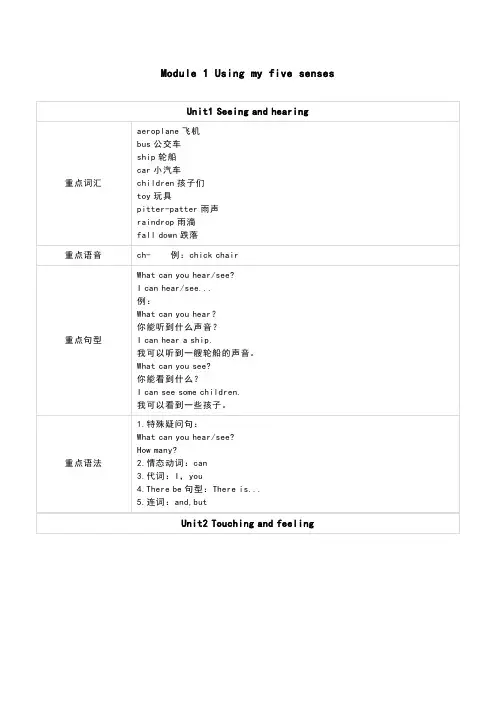
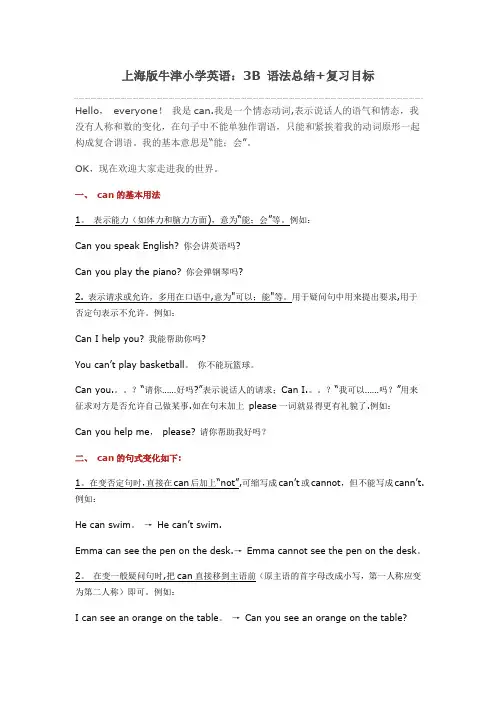
Hello,everyone!我是can.我是一个情态动词,表示说话人的语气和情态,我没有人称和数的变化,在句子中不能单独作谓语,只能和紧挨着我的动词原形一起构成复合谓语。
我的基本意思是“能;会”。
OK,现在欢迎大家走进我的世界。
一、can的基本用法1。
表示能力(如体力和脑力方面),意为“能;会”等。
例如:Can you speak English? 你会讲英语吗?Can you play the piano? 你会弹钢琴吗?2. 表示请求或允许,多用在口语中,意为"可以;能"等。
用于疑问句中用来提出要求,用于否定句表示不允许。
例如:Can I help you? 我能帮助你吗?You can’t play basketball。
你不能玩篮球。
Can you.。
?“请你……好吗?”表示说话人的请求;Can I.。
?“我可以……吗?”用来征求对方是否允许自己做某事.如在句末加上please一词就显得更有礼貌了.例如:Can you help me,please? 请你帮助我好吗?二、can的句式变化如下:1。
在变否定句时,直接在can后加上“not”,可缩写成can’t或cannot,但不能写成cann’t.例如:He can swim。
→He can’t swim.Emma can see the pen on the desk.→Emma cannot see the pen on the desk。
2。
在变一般疑问句时,把can直接移到主语前(原主语的首字母改成小写,第一人称应变为第二人称)即可。
例如:I can see an orange on the table。
→Can you see an orange on the table?其回答可用Yes, OK或Certainly等作肯定回答;用No或Sorry等作否定回答。
例如:—Can you look after my books, please?你能照看一下我的书吗?—OK。
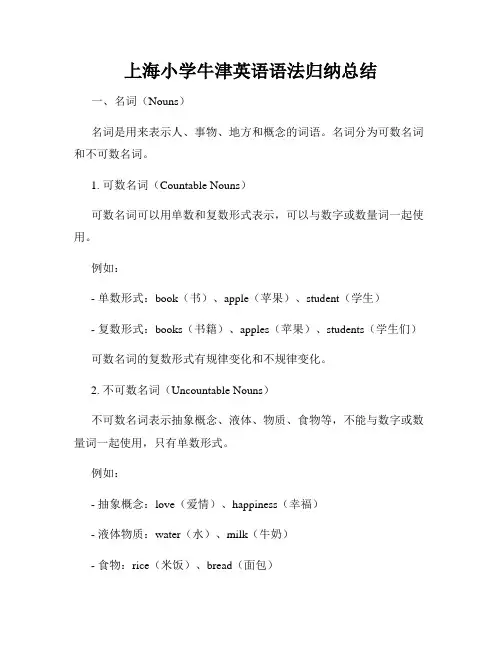
上海小学牛津英语语法归纳总结一、名词(Nouns)名词是用来表示人、事物、地方和概念的词语。
名词分为可数名词和不可数名词。
1. 可数名词(Countable Nouns)可数名词可以用单数和复数形式表示,可以与数字或数量词一起使用。
例如:- 单数形式:book(书)、apple(苹果)、student(学生)- 复数形式:books(书籍)、apples(苹果)、students(学生们)可数名词的复数形式有规律变化和不规律变化。
2. 不可数名词(Uncountable Nouns)不可数名词表示抽象概念、液体、物质、食物等,不能与数字或数量词一起使用,只有单数形式。
例如:- 抽象概念:love(爱情)、happiness(幸福)- 液体物质:water(水)、milk(牛奶)- 食物:rice(米饭)、bread(面包)不可数名词没有复数形式,不能直接与冠词a/an连用。
二、冠词(Articles)冠词用于限定名词的范围,分为定冠词和不定冠词。
1. 定冠词(Definite Article)定冠词是"the",用于特指已经提到的人或物,或者特指上下文中的某人或某物。
例如:- I saw a cat in the tree.(我看到树上有一只猫)- The cat was black.(那只猫是黑色的)2. 不定冠词(Indefinite Article)不定冠词有两种,分别是"a"和"an"。
用于泛指某一类人或物。
例如:- I have a dog.(我有一只狗)- She is an actress.(她是一名女演员)不定冠词"a"后面接辅音音素开头的词,"an"后面接元音音素开头的词。
三、形容词(Adjectives)形容词用来描述名词的特征和性质。
形容词通常位于名词之前。
- a big house(一个大房子)- a beautiful flower(一朵美丽的花)形容词可以用于比较级和最高级。
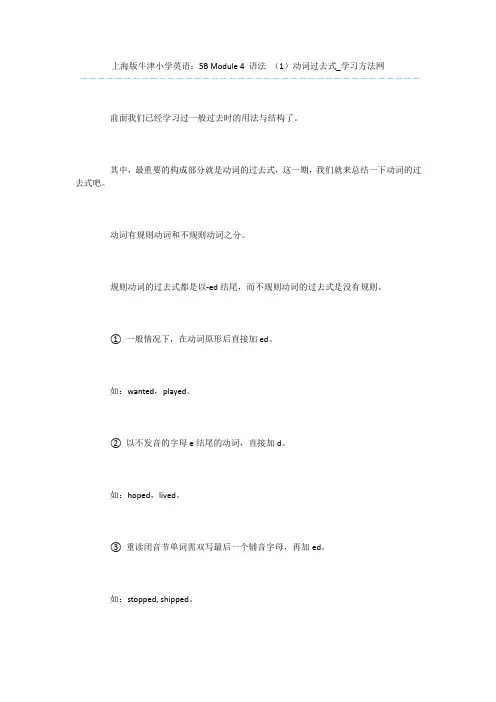
上海版牛津小学英语:5B Module 4 语法(1)动词过去式_学习方法网
---------------------------------------前面我们已经学习过一般过去时的用法与结构了。
其中,最重要的构成部分就是动词的过去式,这一期,我们就来总结一下动词的过去式吧。
动词有规则动词和不规则动词之分。
规则动词的过去式都是以-ed结尾,而不规则动词的过去式是没有规则。
① 一般情况下,在动词原形后直接加ed。
如:wanted,played。
② 以不发音的字母e结尾的动词,直接加d。
如:hoped,lived。
③ 重读闭音节单词需双写最后一个辅音字母,再加ed。
如:stopped, shipped。
④ 以辅音字母+y结尾的动词变y为i,再加ed。
如:studied,worried。
⑤ 有些动词不符合上面的规则,需要特殊记忆。
如:am(is)-was, are-were, go-went, eat-ate, swim-swam, buy-bought, see-saw, lose-lost teach-taught, bring-brought, think-thought,
fall-fell, hurt-hurt, break-broke, win-won,考考你:
将下列动词变成过去式:write______ ring______
A. writed ringed
B. writed rang
C. wrote ringed
D. wrote rang
感谢阅读,欢迎大家下载使用!。
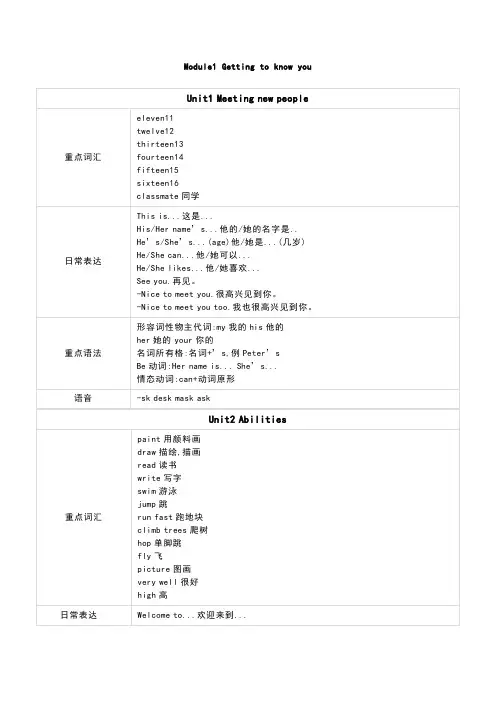
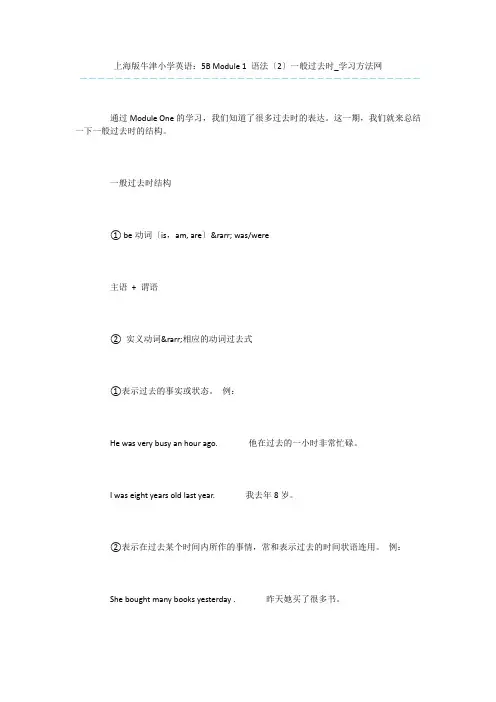
上海版牛津小学英语:5B Module 1 语法〔2〕一般过去时_学习方法网
---------------------------------------
通过Module One的学习,我们知道了很多过去时的表达。
这一期,我们就来总结一下一般过去时的结构。
一般过去时结构
① be动词〔is,am, are〕→ was/were
主语+ 谓语
② 实义动词→相应的动词过去式
①表示过去的事实或状态。
例:
He was very busy an hour ago. 他在过去的一小时非常忙碌。
I was eight years old last year. 我去年8岁。
②表示在过去某个时间内所作的事情,常和表示过去的时间状语连用。
例:
She bought many books yesterday . 昨天她买了很多书。
I played table tennis with my friend last Monday. 上周一我和一个朋友打了乒乓球。
表示过去的时间状语,有:yesterday,last week,last year,two days ago,...
考考你:
Lucy ___ her homework at home yesterday afternoon.
A. did
B. do
C. does
D. done
感谢阅读,欢送大家下载使用!。
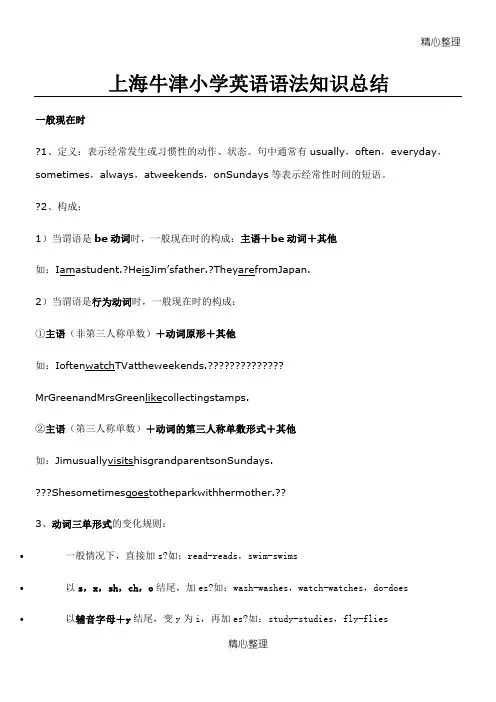
精心整理•一般情况下,直接加s?如:read-reads,swim-swims•以s,x,sh,ch,o结尾,加es?如:wash-washes,watch-watches,do-does•以辅音字母+y结尾,变y为i,再加es?如:study-studies,fly-flies•不规则变化如:have-has•4、一般现在时的句型转换:肯定句否定句一般疑问句及回答They watch TV everyday. They don’twatch TVeveryday.—Do they watch TVeveryday?—Yes,they do./No,they don’t.She watches TVShe doesn’t?watch—Does she watch TVeveryday?如:read-reading,drink-drinking,eat-eating,look-looking•以不发音的e结尾的动词,去掉e,再加ing如:write-writing,make-making,ride-riding,take-taking•以重读闭音节结尾,如末尾只有一个辅音字母,要双写这个字母,再加ing如:sit-sitting,swim-swimming,put-putting,run-running,stop-stopping,get-getting,2、构成:主语+动词的过去式+其他3、动词过去式的变化规则:肯定句否定句一般疑问句及回答—Did he watch TVyesterday? He watched TVyesterday. He didn’twatch TVyesterday.—Yes,he did./No,he didn’t.—Did they play gamesjustnow? They played gamesjustnow. They didn’tplay gamesjustnow.—Yes,they did./No,they didn’t. 一般将来时1、定义:表示将要发生的动作或存在的状态,以及打算、计划或准备某事。
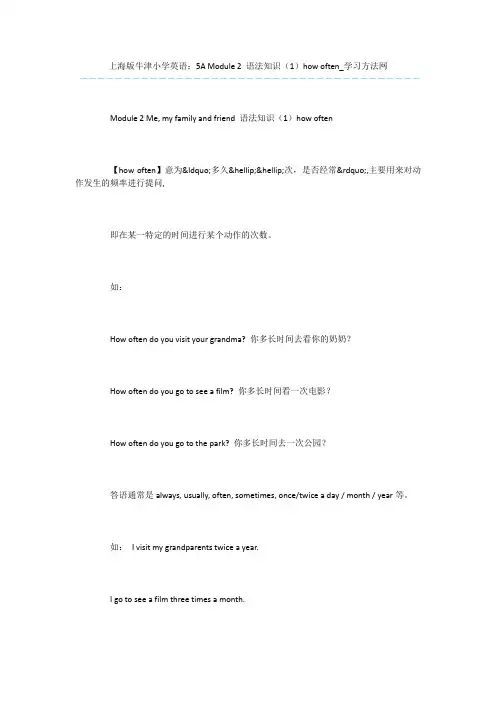
上海版牛津小学英语:5A Module 2 语法知识(1)how often_学习方法网
---------------------------------------Module 2 Me, my family and friend 语法知识(1)how often
【how often】意为“多久……次,是否经常”,主要用来对动作发生的频率进行提问,
即在某一特定的时间进行某个动作的次数。
如:
How often do you visit your grandma? 你多长时间去看你的奶奶?
How often do you go to see a film? 你多长时间看一次电影?
How often do you go to the park? 你多长时间去一次公园?
答语通常是always, usually, often, sometimes, once/twice a day / month / year等。
如:I visit my grandparents twice a year.
I go to see a film three times a month.
【练一练】
___do you visit your grandparents? I visit them twice a month.
A. How long
B. How many
C. How often
D. How soon
感谢阅读,欢迎大家下载使用!。
上海牛津小学英语语法知识总结Document number:PBGCG-0857-BTDO-0089-PTT1998上海牛津小学英语语法知识总结一般现在时1、定义:表示经常发生或习惯性的动作、状态。
句中通常有usually,often,every day,sometimes,always,at weekends,on Sundays等表示经常性时间的短语。
2、构成:1)当谓语是be动词时,一般现在时的构成:主语+be动词+其他如:I am a student. He is Jim’s father. They are from Japan.2)当谓语是行为动词时,一般现在时的构成:①主语(非第三人称单数)+动词原形+其他如:I often watch TV at the weekends.?Mr Green and Mrs Green like collecting stamps.②主语(第三人称单数)+动词的第三人称单数形式+其他如:Jim usually visits his grandparents on Sundays.She sometimes goes to the park with her mother.?3、动词三单形式的变化规则:•一般情况下,直接加s 如:read-reads,swim-swims•以s,x,sh,ch,o结尾,加es 如:wash-washes,watch-watches,do-does•以辅音字母+y结尾,变y为i,再加es 如:study-studies,fly-flies•不规则变化如:have-has•4、一般现在时的句型转换:肯定句否定句一般疑问句及回答They watch TV every day. They don’t watch TVevery day.—Do they watch TV every day—Yes, they do. / No, they don’t.She watches TV every day. She doesn’t watchTV every day.—Does she watch TV every day—Yes, she does. / No, she doesn’t.现在进行时1、定义:表示现在或现阶段正在进行或发生的动作。
上海牛津小学英语语法知识总结精选文档 TTMS system office room 【TTMS16H-TTMS2A-TTMS8Q8-上海牛津小学英语语法知识总结一般现在时1、定义:表示经常发生或习惯性的动作、状态。
句中通常有usually,often,every day,sometimes,always,at weekends,on Sundays等表示经常性时间的短语。
2、构成:1)当谓语是be动词时,一般现在时的构成:主语+be动词+其他如:I am a student.He is Jim’s father.They are from Japan.2)当谓语是行为动词时,一般现在时的构成:①主语(非第三人称单数)+动词原形+其他如:I often watch TV at the weekends.Mr Green and Mrs Green like collecting stamps.②主语(第三人称单数)+动词的第三人称单数形式+其他如:Jim usually visits his grandparents on Sundays.She sometimes goes to the park with her mother.3、动词三单形式的变化规则:•一般情况下,直接加s 如:read-reads,swim-swims•以s,x,sh,ch,o结尾,加es•如:wash-washes,watch-watches,do-does••以辅音字母+y结尾,变y为i,再加es•如:study-studies,fly-flies••不规则变化如:have-has•4、一般现在时的句型转换:肯定句否定句一般疑问句及回答They watch TV every day. They don’t watch TVevery day.—Do they watch TV every day?—Yes, they do. / No, they don’t.She watches TV every day. She doesn’twatchTV every day.—Does she watch TV every day?—Yes, she does. / No, she doesn’t.现在进行时1、定义:表示现在或现阶段正在进行或发生的动作。
上海牛津版三年级(上)Module 1 Getting to know youUnit 1 How are you?教学目标:1.学会在具体语境中正确使用新单词。
2.学会使用固定表达打招呼。
3.学会用固定句型介绍自己和他人。
4.学会表达某些信息。
重点难点:单词:Miss,Mr,Mrs语法:1.人称代词I, you2. 介绍自己I’m…/ 介绍他人This is…3. 给出某些信息We have…打招呼用语:1.Hello!Hi!2. Good morning/afternoon/evening/night.3.—How are you?—Fine, thanks./I’m fine too.课时安排:两个课时知识衔接:要求学生先自我介绍然后互相认识。
以此为情境把本次课的重要单词,句型,语法结合起来教学。
Unit 2 what’s your name?教学目标:1.学会在具体语境中使用关键词和短语。
2.学会用固定表达说出某人的名字。
3.学会使用祈使句做出指示。
重点难点:单词:stand up, sit down, open, close, door, name,book, write日常表达:--what’s your name?--my name is…语法:1人称代词your, my2 祈使句 stand up,sit down,look at课时安排:两个课时知识衔接:上节课大家互相认识了,这节课可以以上节课的内容过渡到询问名字。
Unit 3 how old are you?教学目标:1.学会用wh-questions询问别人的年龄。
2.学会用固定句型谈论别人的年龄。
3.学会询问特定信息。
4.学会表达祝福。
重点难点:单词:one—ten,today日常表达:问年龄-- how old are you?happybirthday!--here you are--thank you. Guess!语法1.数字one—ten2. it’s …/I’m…3.物主代词your4. Are you…?5.祈使句blow…和定冠词the课时安排: 2个课时。
M odule1U sing my five sensesUnit1What a mess!词汇school bag书包brush刷paints颜料crayon蜡笔notebook笔记本glue胶水tape磁带put放置日常表达What a mess!好乱啊!What should I do?我应该做什么?语法1.特殊疑问句例Whose school bag is this?2.代词mine,yours,his,hers,ours,theirs3.祈使句例Put it on her desk,Peter.Unit2Watch it grow!词汇egg鸡蛋cocoon茧caterpillar毛毛虫butterfly蝴蝶chick小鸡chicken鸡duckling小鸭duck鸭子puppy小狗dog狗grow长大fly飞was是were是first首先next接下来then随后finally最后语法1.一般过去时例It was a white egg.2.一般现在时例Now it is a green caterpillar.Unit3How noisy!词汇drill钻(孔);打(眼)lorry卡车motorbike摩托车outside外面sleep睡觉another另外的noise噪音heard听到sat坐日常表达Not at all.一点也不。
语法1.特殊疑问句例What’s that noise?What can you hear?2.一般过去时例Kitty wanted to read a book.M odule2M y favourite thingsUnit1Food and drinks词汇meat肉pork猪肉beef牛肉chicken鸡肉fish鱼肉fruit水果vegetable蔬菜tomato西红柿potato土豆carrot胡萝卜cabbage卷心菜bean豆子rice米饭noodles面条bread面包water水milk牛奶tea茶orange橙子grape葡萄apple苹果banana香蕉drink饮料milk牛奶had有eat吃healthy健康的did做keep...away远离日常表达...is/are my favourite food.是我最喜欢的食物。
四上期末综合复习一、语法归纳【知识梳理1】数词*基数词的写法:21~99的两位数,十位与个位之间用连字符“”。
例:21 twenty one 32 thirty two 99 ninety – nine2. 序数词的构成1)一般来说,是由相应的基数词加词尾th构成。
例,four + th fourth six + th sixth seven + th seventh ten + th tenth2)下面这些基数词在变为序数词时,有特殊的变化。
例,one first two second three third five fifth eight eighth nine ninth twelve twelfth【知识梳理2】介词I. 方位介词in, on, at, between, under, in front of, behind, next toat: 在某地点(小地点)at the bacon stall at home at school at the bus stop/post officein: 在某地(大地点)in the classroom/library in the hall/gym in Shanghai/in China in the world on: a. 在...上面on the 2nd floor在2楼on the desk在桌子上b. 在靠近...的地方on the right/left在右边/左边on the river在河边between: 在...(二者)之间There is a hospital between the school and the shop.在学校与商店之间有所医院。
under: 在...正下方They are sitting under a big tree. 他们坐在一棵大树下。
in(the) front of:在...前面A river flows in front of the house. 房子前有一条河。
四年级英语语法知识汇总一、词类:1、名词这里强调两点:不可数名词都默认为单数,所以总是用is名词复数如何加后缀:人称代词:有主格和宾格之分。
一般动词前用主格,动词后用宾格。
3、指示代词4、冠词有a、an、the。
a和an的区别:an用于元音音素(一般就是元音字母a、e、i、o、u)前,a用于辅音音素前。
二、否定句:be动词(am、is、are)+not、情态动词can+ not、助动词(do、does)+ not如何将一个肯定的陈述句改为否定句:1、看句中有无be动词,如有,直接在be动词后+ not。
2、看句中有无情态动词,如有,直接在情态动词后+ not。
3、如上述二者都没有,就应用助动词+ not。
分四个步骤:(1)肯定陈述句中本来是没有助动词的,要加上去,位置在主语(某人或某物)后,动词前。
(2)确定助动词用do、does,根据句中动词,动词是原形的助动词就用do,动词是第三人称单数的助动词就用does,(3)在助动词后加not。
(4)原句中动词假如发生变化就要恢复成原形。
强调一点,有some的要考虑是否要用any。
三、一般疑问句。
如何将一个肯定的陈述句改为一般疑问句:1、看句中有无be动词,如有,把be动词提到句首即可。
2、看句中有无情态动词,如有,把情态动词提到句首即可。
3、如上述二者都没有,就应把助动提到句首。
分四个步骤:(1)肯定陈述句中本来是没有助动词的,要加上去,位置在主语(某人或某物)后,动词前。
(2)确定助动词用do还是does,根据句中动词,动词是原形的助动词就用do,动词是第三人称单数的助动词就用does(3)把助动词后提到句首。
(4)原句中动词假如发生变化就要恢复成原形。
强调一点,有some的要考虑是否要用any。
四、特殊疑问句。
表示疑问,有疑问词(在开头),回答有很多种可能。
1、一般现在时(1)一般现在时中的be动词:一般用原形:am is aream用于第一人称单数(I);is用于第三人称单数(he she it和其他人名或称谓,如:Ben his sister 等);are用于第二人称单数(you)和所有复数(包括第一人称复数we、第二人称复数you;第三人称复数they和其他复数,如the children 、his parents等)。
上海牛津小学英语语法知识总结一般现在时1、定义:表示经常发生或习惯性的动作、状态。
句中通常有usually,often,every day,sometimes,always,at weekends,on Sundays等表示经常性时间的短语。
2、构成:1)当谓语是b e动词时,一般现在时的构成:主语+be动词+其他如:I am a student. He is Jim’s fathe r. They are from Japan.2)当谓语是行为动词时,一般现在时的构成:①主语(非第三人称单数)+动词原形+其他如:I often watch TV at the weekends.Mr Green and Mrs Green like collecting stamps.②主语(第三人称单数)+动词的第三人称单数形式+其他如:Jim usually visits his grandparents on Sundays.She sometimes goes to the park with her mother.3、动词三单形式的变化规则:①如:read-reads,swim-swims②如:wash-washes,watch-watches,do-does③如:study-studies,fly-flies④如:have-has4、一般现在时的句型转换:现在进行时1、定义:表示现在或现阶段正在进行或发生的动作。
句中常有now ,look ,listen 等词。
如:I am washing clothes now. Look! Liu Tao is climbing the tree.Listen! Jane is singing in the music room.2、构成:be 动词(am/is/are )+ 动词现在分词(V-ing )3、动词现在分词构成:① 如:read-reading ,drink-drinking ,eat-eating ,look-looking ② 如:write-writing ,make-making ,ride-riding ,take-taking③ 如:sit-sitting ,swim-swimming ,put-putting ,run-running ,stop-stopping ,get-getting ,begin-beginning ,jog-jogging ,forget-forgetting4、动名词其实就是动词的现在分词,它既有名词性质(可作主语),又有动词性质(可带宾语)。
如:Asking the wayMy hobby is collecting stamps.He is good at skating.5、现在进行时的句型转换:一般过去时1、定义:表示过去某个时间里发生的动作或存在的状态。
常和表示过去的时间状语连用,如:a moment ago,just now,yesterday,last week,this morning等。
如:My brother often went to school by bike last term.The watch was beside the diary a moment ago.I watched the moon and ate the moon cakes last Mid-Autumn Festival.Jim went to the supermarket yesterday.2、构成:主语+动词的过去式+其他3、动词过去式的变化规则:①如:play-played,listen-listened,look-looked②如:live-lived ,like-liked ,taste-tasted ③如:study-studied ,carry-carried ,cry-cried④如:stop-stopped ,plan-planned ⑤ 如:am/is-was are-were have/has-had do-did go-went sit-sat tell-told see-saw get-got make-madegive-gave read-read buy-bought come-came draw-dreweat-ate fly-flew meet-met put-put run-ransay-said sing-sang swim-swam take-took4、一般过去时的句型转换一般将来时1、定义:表示将要发生的动作或存在的状态,以及打算、计划或准备某事。
句中一般含有表示将来的时间状语,如:tomorrow morning,next week,this afternoon等表示将来的时间状语。
2、构成:①be gong to +动词原形如:I am going to see a Beijing opera tomorrow.We are going to meet at bus stop at half past ten.Dad and I are going to see a Beijing opera this afternoon.②will +动词原形如:They will go swimming this afternoon.3、be going to 和will 区别:① be going to表示经过事先安排、打算或决定要做的事情,基本上一定会发生;will则表示有可能去做,但不一定发生,也常表示说话人的临时决定。
如:I am going to take part in a party this evening.They are cleaning the libra ry now. I’ll go and join them.②be going to表示近期或眼下就要发生的事情;will表示的将来时间则较远一些。
如:He is going to write a letter tomorrow. I will meet her one day.③ be going to还可以用来表示有迹象表明某件事将要发生,常用于天气等自然现象。
如:Look! It’s going to rain.4、一般将来时句型转换:句法1、陈述句说明事实或陈述说话人观点的句子。
基本结构:主语+谓语+其他1)肯定陈述句We all like pandas very much.2)否定陈述句He doesn’t do house work at weekends3)肯定陈述句改否定陈述句①一般是在b e动词或情态动词后加not。
Mary was at school yesterday. —> Mary was not at school yesterday.I can make a model plane. —>I can not make a model plane.②不含be动词或情态动词的,行为动词前要用助动词的否定式(don’t,doesn’t,didn’t),后面跟动词的原形。
He likes drawing pictures.—>He doesn’t like drawi ng pictures.I went to the park yesterday. —>I didn’t go to the park yeste rday.4)陈述句改一般疑问句①有be动词或情态动词的,把be动词或情态动词提前。
Mary was at school yesterday. —> Was Mary at school yesterday?I can make a model plane. —> Can you make a model plane?②不含be动词或情态动词的句子,借助助动词开头,动词还原成原形。
He likes drawing pictures.—>Does he like drawing pictures.I went to the park yesterday. —>Did you go to the park yesterday?2、疑问句用来提出问题,询问情况的句子,末尾用问号。
1)一般疑问句:一般疑问句常用来询问一件事是否属实,通常以be动词,助动词或情态动词开头,用yes或no来回答,因此又叫是非疑问句,通常读升调。
—Is Mr Green from the UK? —Yes,he is. / No,he isn’t.—Do you have any hobbies? —Yes,I do. / No,I don’t.—Can you play the guitar? —Yes,I can. / No,I can’t.2)特殊疑问句:以特殊疑问词引导,要求回答具体问题,不能用yes或no来回答。
—How do you go to work every day? —I go to work by car.3)选择疑问句:提供两种或两种以上情况,让对方选择,往往用or连接。
—Would you like some tea or coffee? —Some coffee, please.4)反意疑问句:反意疑问句是由陈述句和附在其后的附加疑问句组成。
—It’s a fine day, isn’t it? — Yes ,it is.3、祈使句表示请求或命令别人做某事或不做某事。
1)用于第二人称,通常省略you。
①肯定祈使句:Open the door, please.②否定祈使句:Don’t be late again.2)用于第一人称和第三人称,通常以let(let后跟宾格)或shall开头。
Let me have a look. Let’s play a game now. Let him go home now.Shall we meet at one thirty in front of the Garden Theatre?4、感叹句表达喜怒哀乐等强烈感情,句尾常用感叹号(!),语气用降调。
1)what + 名词或名词性短语What a big garden (it is)!What an interesting storybook (it is) !What lovely weather (it is)!What pretty girls (they are)!2)how +形容词或副词+主语+动词How nice!How beautiful the flowers are!How tall Yao Ming is!5、there be 句型表示在某地有某人或某物。